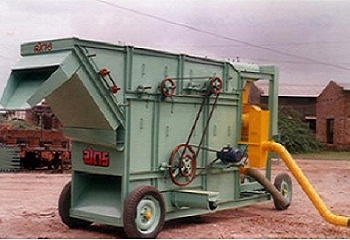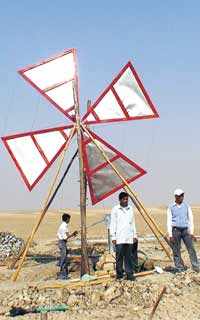If technology is like words, institutions are like grammar and culture is like a thesaurus. In this section, we have innovations by common people from different parts of the country. Most of these innovations are extremely frugal, affordable, socially and environmentally compatible and generally gender neutral. In some cases, the formal sector has added value in terms of design, functionality, durability, or flexibility. Majority of these innovations are available for licensing and/or social diffusion in collaboration with the innovator. The queries regarding entrepreneurship, investment or wider dissemination are most welcome.
Flying high with hope, spirit and technology
-
Cotton stripper machine
Born in a farming family, Mansukhbhai would often help his father on the farm, especially with the farm machinery. As a child, Mansukhbhai had great interest in mechanical and electrical appliances and he would tinker with these whenever he had an opportunity. But he could only study till high school.
Mansukhbhai saw a business opportunity in automating the process of separating lint from cotton bolls in local cotton varieties. He developed the first prototype of the Cotton Stripper Machine in 1994. More changes were introduced in the next three years. In 2001, he introduced dust collectors and fitted an automatic feeding system to the machine. He also provided wheel-brackets and castors to make the machine portable.

Mansukhbhai’s stripping machine innovation was scouted by SRISTI. Grassroots Innovations Augmentations Network (GIAN – West), took up the task of value addition. Mansukhbhai was put in touch with the Council of Scientific and Industrial Research (CSIR) and other arms of the Department of Science and Technology (DST). With GIAN’s support, per hour and improves the quality of cotton. (Vol 8 – 2 – Apr – Jun 1997)
- Laxmi Asu making machine
Before weaving various patterns on the loom, a hand winding process of yarn is required in the traditional “Tie & Dye” Pochampalli silk saree tradition. This is a tedious and cumbersome process. The Pochampalli silk sari is an exquisite tradition of double ikat style of weaving with a wide variety of colours and intricate designs of geometrical patterns. It is distinctive because the design on the front of the sari is same as on the back.
Before weaving these patterns on the loom, the yarn has to be hand wound in process known as Asu. This process involves moving the hands, over a space of one meter up and down around semi-circularly arranged pegs, 9 000 times for one sari, demanding high concentration and accuracy. The yarn has to be hand wound on each peg four times before moving to the next peg. For each sari almost four to five hours of winding is required. The entire design process is totally dependent on the Asu process. To learn more (Vol 19 – 3 – Jul – Sep 2008)
- Dadaji – HMT improved paddy variety
Dadaji Ramaji Khobragade is a progressive farmer who has developed many rice varieties. Among them, Dadji HMT is one which was developed from Patel 3 variety through selection. The variety is white, thin and matures at 130-135 days. It has high resistance, high recovery percentage and yields upto 45q/ha. The variety has already been granted a certificate of registration under PPVFRA. Learn more (Vol 20 – 4 – Oct-Dec 2009)
- Innovation from Assam is creating ripples on Saurashtra’s coast
Manually drawing water from tubewells or bore wells is tiring. Mohammad Hussain and Mushtaq Ahmad, dist. Darrang, Assam devised a simple windmill using locally available materials like bamboo, timber, strips of old tyres and pieces of iron to ease the process of drawing water. The technology was awarded by NIF in 2007.

In 2008, the Network was looking to use another innovation, the Bullet Santi for harvesting salt from salt panes. During one such visit the GIAN team observed that the location had ample wind and the water tables were not deeper than fifty feet. It was soon realised that the windmill could be used for pumping water for the salt farming.

